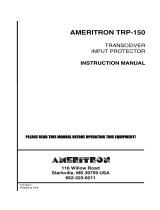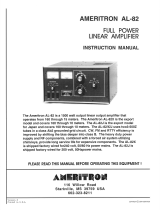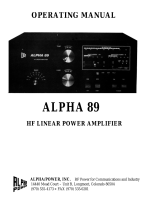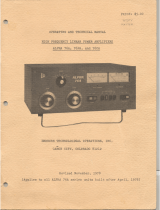Page is loading ...

AMERITRON SDC-105
Automatic Screwdriver Antenna Controller
for ALLTransceivers.
INSTRUCTION MANUAL
PLEASE READ THIS MANUAL BEFORE OPERATING THIS MACHINE!
_______________________________________________________________________
116 Willow Road
Starkville, MS 39759 USA
662-323-8211
www.ameritron.com
Version 1C

2
Introduction:
The SDC-105 Screwdriver Antenna Controller will automatically adjust the
screw driver antenna to the Transceiver’s frequency. The controller senses RF
an automatically moves the antenna to the correct location. The controller has a
two speed motor control for reaching the desired location in less time. There are
no cables to connect to the transceiver. The controller gets its information from
the feed line RF sensor and the antenna’s internal counter switch.
The antenna must have an internal sensor switch installed for the antenna
controller to operate properly. If your antenna does not have a sensor, contact
the antenna manufacture or Ameritron.
Features:
Automatic antenna tuning
2 Speed motor control
RF sense display
Frequency display
VSWR display
Current display
Antenna directional indicator
Manual UP/ DOWN buttons
Adjustable current sense trip for Antenna Motor Production
Antenna turns counter
Reverse polarity
Home
Operation controls
Power: Switches the controller’s power on and off.
Up: Moves the antenna up.
DOWN: Moves the antenna down.
SETUP: Allows programming of the antenna
SKIP: Navigates thru the menus
ENTER: Stores the menu setting.
TUNE: Moves the antenna to a programmed setting for the displayed
frequency or fine tunes the antenna if RF is present.
HOME: Lowers the antenna all the way down and turns the motor off.
INSTALLATION:
1. The Red Power Wire needs to be fused to protect the controller and the
antenna. The fuse must be no larger than a 5 amp rating. Some antennas may
require a lower current rating. Refer to the antenna’s manual for the current
WARINGING: Do not reverse the polarity of the Red and Black wires.
Damage will occur to the controller.

3
rating. Connect the Red wire to a +12 VDC Supply. Use 16 gauge wire when
adding additional length.
2. Connect the Black wire to the negative of the power supply or chassis ground.
3. Connect the four prong Molex plug to the antenna. Note: Some antennas do
not have the correct plug to match the controller’s plug. The mate can be order
thru Ameritron part number 13-TAR102-2. Or the plug can be cut off and hard
wire to the antenna. See pictorial for wire color and its functions.
Antennas that do not have a 4 pin plug. The plug can be cut
off. Use the chart below for wire color and its function.
CONTROL CABLE
RED MOTOR WIRE
BLACK MOTOR WIRE
GREEN SENSOR
WHITE SENSOR
WARNING: An RF choke must be placed around the control lines at
the antenna. The Controller may be damaged if an RF
choke is not used.
Motor Operating Voltage
This control unit is designed to operate with a screwdriver antenna that operates
on 12 volts. Some antennas operate on only 3 or 4 volts, a Dropping Resistor
can be used inline with the motor wires to bring the voltage down. Consult your
antenna manual or manufacturer for the operating voltage.
motor control

4
Important: Failure to adjust and operate your screwdriver
antenna at the proper voltage will damage the
antenna motor.
If a dropping resistor is necessary, a good value to try is 5 Ω/10 Watts. This
resistor will need to be placed inline on one of the motor control lines anywhere
in between the controller and the antenna. If you are not sure whether or not this
resistor is necessary for your antenna, try it and inspect the torque and speed of
the motor. If the motor is too slow, reduce or eliminate the resistance. Use of
12 volts with a 3 or 4-volt antenna will result in failure of the motor.
WARNING: Do not apply voltages greater than 18 volts to this unit, or
permanent damage to the unit and antenna may result.
4. Connect the RF sensor inline with the Antenna’s RF Feed Line.
5. Connect the supplied Cat 5E cable from the Sensor’s Remote Jack to the
Controller’s Remote Jack.
Checking operation:
1. Switch controller to on.
The Display will read F=000 P-0
Note: The motor control current limit is set for 2 Amps. This could be too
much for some antennas. The current limit can be change in the TRIP menu to
match the antenna requirements. See Instruction under TRIP for more details.
2. Press the UP Button and release while watching the display. A letter U
should appeared to indicate the antenna is moving up and the turns counter
(pulse) represented by the letter P should have been counting. The C will
indicate the current of the antenna’s motor.
3. Press the Down Button and release while watching the display. A letter D
should appear and the counter (P) should have been counting down. The C will
indicate the motor’s current.
A TRIP indication means the motor current is higher than the menu trip current
setting. The current limit will need to be set to a higher current. See
Instructions under TRIP for details.

5
Note: The counter will not count below zero. The antenna will continual
moving but the counter will stay at zero if the antenna is not at it lowest
location.
Notice the direction of the antenna when pressing the UP button. If the antenna
is going the wrong way the polarity can be changed in the menu or the motor
wires can be swapped. See instructions under Polarity for details. Note: The
power supply wire for the controller can not be swap to change the polarity.
Only the motor control wires going to the antenna.
4. Place the Transceiver into a carrier mode. CW, RTTY, FM or FSK
5. Set Transceiver’s power to 10 watts.
6. Set Transceiver to 10 meters.
7. Apply RF and release. The antenna controller should have displayed the
transceiver’s frequency. The letter R will indicate RF is being detected. The
VSWR is indicated by the S. If the frequency is a little off it can be adjusted
under menu setting AJUST.
Programming:
The way the controller operates is it reads the frequency then moves the antenna
to the closest programmed setting that has been stored for that frequency. To
make the controller more accurate to move the antenna to the best resonate
location it may be necessary to program more than one setting within a band.
The controller will allow 8 different setting for each band.
Programming the Antenna.
1. Press the down Button to move the antenna all the way down. If the down
button moves the antenna the wrong way, the motor control wires can be
swapped or the polarity can be changed in the controller’s menu POL. See
instruction under Polarity to change the polarity to the antenna’s motor.
With the antenna all the way down the controller should be displaying 0 for
Pulse, 0 for Current and transceiver’s frequency. If the counter is not at 0 refer
to CLRP to clear the counter. It is easier to tune the highest frequency first
since the antenna is already at its lowest setting. The transceiver will need to be
in FM, RTTY or FSK during this process. Power level about 10 watts of RF.
2. Set the transceiver to the desired frequency for the antenna to be tuned.
3. Move the antenna up to tuned (resonant) position. This should be where the
antenna is at its lowest VSWR. Normally this is done by pressing the MIC KEY
to create RF and move the antenna until you reach the lowest VSWR. Refer to
the Antenna’s manual for question about tuning the antenna.

6
4. After the antenna is tuned to the correct position. Verify the display is
showing the Transceiver’s frequency and the P is showing the turns of the
antenna.
5. Press the SETUP button until the word STORE appears.
6. Momentary press the ENTER button. The display will read the Band and
memory location 1 in the bottom right of the display. Since this is the first stored
location for this band the location will be stored in memory 1.
7. Momentary press ENTER. The location of the antenna has been stored under
memory 1 for that band. The controller will store up to 8 positions for each
band. Normally 6, 10, 12, 15, 17 Meters will only need one setting for each
band to cover the whole band.
8. Repeat step 2 thru 7 to store a location for each band.
Some bands like 80 meters the antenna has to be moved to different spots to
keep the VSWR low within that Band. In this case it is best to program more
than one setting for 80 meters.
Example:
a. Set the transceivers Frequency close to the top of 80 meters. Move the
antenna to resonant (lowest VSWR).
b. Press the SETUP button until STORE appears.
c. Momentary press ENTER. 80 1 will appear.
d. Momentary press ENTER. This stored the position in memory 1 for 80
meters.
e. Watching the VSWR and applying RF. Start turning the transceiver’s
Frequency down until the VSWR gets too high. (2.5).
f. While applying RF move the antenna UP until the VSWR drops below 1.5:1.
g. Press the SETUP button until STORE appears.
h. Momentary press the ENTER button. 80 1 will appear.
i. Momentary press the SKIP button 80 2 will appear.
j. Momentary press the ENTER button. This location is now stored under
memory 2 for the 80 meter band.
Repeat e thru f to store more locations under memory 3 thru 8 for the 80 meter
band if needed.
OPERATIONS:
Manual Mode:
Set the Transceiver to the desired Frequency.
Using CW, FM, RTTY, FSK or a steady tone thru the mic apply RF until the
display reads the transceiver’s frequency.
If the antenna is not set for the correct band or the VSWR is too high momentary
press the TUNE button. With no RF applied the controller will move the antenna
to the programmed setting closest to the displayed frequency.
IF the VSWR is still too high press the TUNE button while applying RF. The
controller will adjust the antenna until the VSWR gets below 1.5:1. If the
VSWR does not get below 1.5:1 within a few seconds it will time out and stop.

7
Note: RF has to be present during the whole tuning for Low VSWR process. If
the Sensor losses RF the controller will assume the VSWR dropped below 1.5:1
and stop tuning.
Auto Mode the controller will automatically move the antenna to the stored
location without having to press the TUNE button.
If RF is present the controller will tune the antenna if the VSWR is higher than
1.5:1.
Display:
U Indicates the UP button is pressed
D Indicates the Down button is pressed
R Indicates RF is present.
S The VSWR reating at the antenna jack of the sensor box.
P The number of pulses or turns detective form the antenna’s internal
Switch.
C The amount of current the antenna motor is using.
F The Frequency detected by the RF sensor.
TRIP Indicates the motor current limit has been reached.
* Indicates the processor is operating
HOME (Auto Park)
Home mode moves the antenna down until the current limit is reached and stops.
If the motor trip current is reach when the count is below 10 it will stop the
motor and set the counter to zero.
To enter HOME mode Press and hold the UP and DOWN buttons at the same
time until HOME is displayed.
Menus:
Pressing the SETUP button for a few seconds will allow the controller to inter
into the Menu Mode.
Momentarily pressing the SKIP button will navigate thru the following menus.
Momentarily pressing the ENTER button will allow you to make changes to that
menu. Pressing ENTER button again will save changes to that menu.
STORE This menu is used to store the location of the antenna for each band. 8
different locations can be stored for each band. If an antenna setting needs to be
change the new setting can be programmed over the old setting without having
to erase all menus.
POL Allows the direction of the antenna to be changed without having to swap
the motor wires.

8
TRIP The controller has a current limit to help prevent the antenna’s motor
from damage. When the current reaches the programmed setting it will turn the
motor off. This is a good way to protect the motor from motor stall when the
antenna is all the way at the bottom or top. Also if there is an object or
something to prevent the antenna from moving the current limit will trip.
The current limit can be changed in the controller’s menu under Trip. The
controller is factory set for 2.0 amps. The current limit can be changed from 0.1
to 5.0 amperes with 100 milliamps increments.
INIT Returns the menus and displays back to factory setting. This will erase all
antenna location settings. The current limit will be set back 2.0 amps. The
polarity will return to normal. The Mode will return to manual.
CLRP Clears the antenna counter (pulse) to zero. No other changes will be
made.
ADJUST Using the up and down buttons will allow calibrating the frequency
counter to the transceiver’s frequency.
COAST has no function
MODE allows Manual or Auto operation
Manual Operation allows you to switch bands or move around with in the
same band with out the controller trying to move the antenna. (This is good for
searching for activity on the bands) Once the frequency has been determine
momentary press the TUNE button. The controller will move the antenna to
the closest stored memory location.
If RF is present the controller will fine tune the antenna to the lowest VSWR.
Auto Operation The controller will move the antenna to the closest
programmed setting when the frequency or band has been changed.
When RF is present it will fine tune the antenna.
Note: The antenna will be moving around a lot when searching thru the bands
for activity. When using voice such as SSB the frequency counter may not read
the correct frequency since the modulation is moving up and down rapidly. Best
result will be to keep the controller in Manual mode for SSB operations.

9
Trouble Shooting:
Controller does not count but antenna moves up and Down
An. 1. Check the plug for loose connection.
2, Need to determine if it is the antenna or controller.
Disconnect the antenna’s control cable from the controller. Take the end of the
cable going to the controller. Press the Up or Down button and tap the two
sensor pins together. The counter will increment each time the pins are touched
together and then separated. (The up or down button must be press during the
test) The controller is good if the counter increments. It will be the antenna at
fault or a bad wire going to the antenna.
Display will not turn on.
1. Check the power lines to the controller for 12 to 15 Volts DC.
2. If a fuse was installed in the power line, check the fuse.
The controller does not read the Transceiver’s Frequency and no R is displayed
1. Make sure the sensor box is connect to the RF feed line.
2 Make sure the cat 45E is connected to the remote jacks not the meter jack.
3. Check to see if the transceiver is putting out RF.
4. Try increasing the RF to 15 watts or more.
The Display reads TRIP when the up or down button is pressed.
1. Trip current set too low. See instruction under menu TRIP
2. Antenna is in a bind.
3. Check the supply voltage for a low voltage or loose connection
4. Remove the Antenna’s control cable from the controller. Press the up or
down button. Control will have a defect if still get a TRIP fault. Relay contacts
maybe stuck.

10

11
/
















